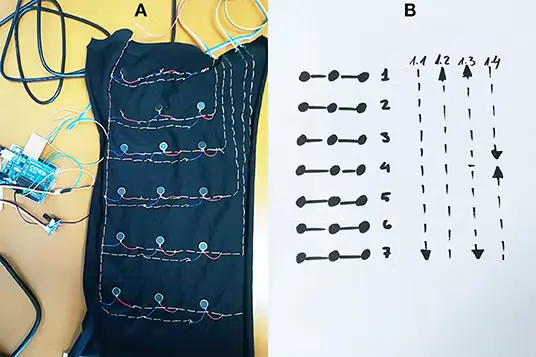“The Magic Lining: Exploring the Psychological Impact of Vibrational E-Textiles on Human Perception and Emotion”**
Hey there, fellow textile enthusiasts! It’s Textile Topher here, ready to weave another fascinating tale from the world where fabric and technology intersect. Today, we dive into the riveting realm of e-textiles and explore how vibrating clothes could potentially alter not just your style but also your state of mind. Let’s stitch this story together!
The Fabric of Perception: Can Clothing Influence Our Minds?
Clothing has always been a potent medium for self-expression. It shapes not only how we look but also how we feel and how others perceive us. But imagine a world where your clothes do more than just fit well or look good—they could actually change your mental state. That’s precisely what a groundbreaking study published in the journal *Frontiers* earlier this year suggests.

The study was conducted by an expert team including Ana Tajadura-Jiménez, Kristi Kuusk, and Aleksander Valjamae, who explored the possibility of using vibrating clothes to enhance your perceptions and emotions. They found that by altering vibration patterns within clothing, they could potentially make wearers feel stronger, calmer, and more confident.
How Does It Work? The Magic of Vibration
The heart of this research lies in what the team calls the “Magic Lining”—a garment studded with small vibration motors. In their experiment, the researchers used 21 off-the-shelf vibration motors controlled by an Arduino Uno microcontroller board. Arduino is an open-source electronics platform based on easy-to-use hardware and software, perfect for this kind of prototyping. By programming these motors to activate in different patterns, they created distinct tactile sensations that participants reported back on.
In their first experiment, the team tested three specific areas on the body— the arm, the center of the back, and the upper back. They generated vibration patterns that moved either outward or inward and asked subjects to describe what they felt. Interestingly, outward-moving patterns on the back made participants feel like they were composed of air, water, or sand, imbuing them with feelings of relaxation, strength, or confidence. In contrast, inward-moving patterns evoked feelings of heaviness, rigidity, anxiety, and even a sensation of being pressed by an external force.
The Spiderweb of Sensations
Taking a cue from their initial results, the researchers designed a second prototype, upping the ante with 25 motors arranged in a spiderweb-like configuration on a piece of felt fabric. This time, they categorized the sensations into three distinct themes: water, cloud, and rocks.
Each theme was meticulously designed. For instance:
Water** was intended to convey smooth, flowing, and cold sensations.
Cloud** aimed to be light, soft, warm, and airy.
Rocks** had to feel stiff, polished, edgy, and heavy.
Participants placed their hands on two types of fabric samples—fluffy polyester and black waffle polyester—and experienced these vibration patterns. Results indicated that the intended concepts (water, cloud, rocks) were indeed aligned with participants’ subjective experiences, validating the hypothesis.
A Rich Legacy of E-Textiles
But wait, vibrating clothes are not the only marvels in the world of e-textiles. This field has a storied past and an exciting future. Conductive threads and fabrics have existed for centuries but gained mainstream attention in the 1960s. An exhibit titled “Body Covering” at the Museum of Contemporary Craft in New York City showcased innovations from self-heating clothing to early spacesuits.
Today, companies like Google with its Jacquard project are taking e-textiles to another level. Imagine snapping a photo with a gesture on a jacket sleeve or skipping a song with a swipe. These are no longer ideas of the future but the innovations of today. Google’s Jacquard technology integrates tiny Bluetooth-enabled fobs into fabrics, opening numerous possibilities for smart clothing.
E-Textiles and the Future of Wellbeing
The fusion of textiles and technology is not just about convenience or novelty; it has genuine potential for enhancing human wellbeing. Retailers, such as Adidas, are embedding wearable tech into shoes that fuse gaming and the real world, adding a layer of interactivity to everyday activities.
Kristi Kuusk reflects on this potential, noting that garments caring for us both physically and mentally is an essential frontier to explore. Imagine a future where your clothes actively contribute to your mental wellbeing, helping you feel calmer, more confident, or more energized depending on what your day demands.
Key Concepts and Terminology in Smart Textiles
1. E-Textiles (Electronic Textiles): These are fabrics that have electronics and interconnections woven into them, enabling functional capabilities beyond that of traditional fabrics. Examples include clothes that light up based on your mood or fabrics that can monitor health parameters.
2. Arduino: An open-source electronics platform used for building digital devices and interactive objects that can sense and control both physically and digitally. In the Magic Lining experiment, Arduino microcontrollers were crucial for programming and controlling the vibration motors.
3. Conductive Threads and Fabrics: These materials can carry electronic signals and power, making it possible to integrate electronic components directly into textiles. They have been around for centuries but have seen a boom in usability thanks to modern technology.
4. Haptic Feedback: This refers to the use of touch to communicate with users. When integrated into fabrics, haptic technology can create a new layer of experience that can inform or enhance the user’s interaction with their clothing.
The textile horizon is broad and promising, and studies like Tajadura-Jiménez and her team’s “Magic Lining” push us toward a more immersive, interactive future. Whether it’s feeling like you’re made of water or clouds, or snapping selfies with your jacket, the intersection of textiles and technology is a thrilling frontier beckoning us to explore.
So, next time you slip into your favorite outfit, consider the incredible possibilities that might soon be at your fingertips—or rather, at your skin. Until then, keep your threads tech-savvy and your mind wide open. This is Textile Topher, signing off! Stay vibrant!
Keywords: E-Textiles, Vibrating Clothes, Arduino, (Post number: 117), Magic Lining, Haptic Feedback





